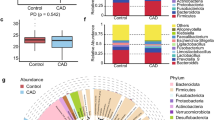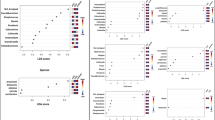Abstract
The association between atherosclerosis and gut microbiota has been attracting increased attention. We previously demonstrated a possible link between gut microbiota and coronary artery disease. Our aim of this study was to clarify the gut microbiota profiles in coronary artery disease patients using data mining analysis of terminal restriction fragment length polymorphism (T-RFLP). This study included 39 coronary artery disease (CAD) patients and 30 age- and sex- matched no-CAD controls (Ctrls) with coronary risk factors. Bacterial DNA was extracted from their fecal samples and analyzed by T-RFLP and data mining analysis using the classification and regression algorithm. Five additional CAD patients were newly recruited to confirm the reliability of this analysis. Data mining analysis could divide the composition of gut microbiota into 2 characteristic nodes. The CAD group was classified into 4 CAD pattern nodes (35/39 = 90 %), while the Ctrl group was classified into 3 Ctrl pattern nodes (28/30 = 93 %). Five additional CAD samples were applied to the same dividing model, which could validate the accuracy to predict the risk of CAD by data mining analysis. We could demonstrate that operational taxonomic unit 853 (OTU853), OTU657, and OTU990 were determined important both by the data mining method and by the usual statistical comparison. We classified the gut microbiota profiles in coronary artery disease patients using data mining analysis of T-RFLP data and demonstrated the possibility that gut microbiota is a diagnostic marker of suffering from CAD.



Similar content being viewed by others
References
Qin J, Li R, Raes J, Arumugam M, Burgdorf KS, Manichanh C, Nielsen T, Pons N, Levenez F, Yamada T, Mende DR, Li J, Xu J, Li S, Li D, Cao J, Wang B, Liang H, Zheng H, Xie Y, Tap J, Lepage P, Bertalan M, Batto JM, Hansen T, Le Paslier D, Linneberg A, Nielsen HB, Pelletier E, Renault P, Sicheritz-Ponten T, Turner K, Zhu H, Yu C, Li S, Jian M, Zhou Y, Li Y, Zhang X, Li S, Qin N, Yang H, Wang J, Brunak S, Dore J, Guarner F, Kristiansen K, Pedersen O, Parkhill J, Weissenbach J, Meta HITC, Bork P, Ehrlich SD, Wang J (2010) A human gut microbial gene catalogue established by metagenomic sequencing. Nature 464:59–65
Wang Z, Klipfell E, Bennett BJ, Koeth R, Levison BS, Dugar B, Feldstein AE, Britt EB, Fu X, Chung YM, Wu Y, Schauer P, Smith JD, Allayee H, Tang WH, DiDonato JA, Lusis AJ, Hazen SL (2011) Gut flora metabolism of phosphatidylcholine promotes cardiovascular disease. Nature 472:57–63
Koeth RA, Wang Z, Levison BS, Buffa JA, Org E, Sheehy BT, Britt EB, Fu X, Wu Y, Li L, Smith JD, DiDonato JA, Chen J, Li H, Wu GD, Lewis JD, Warrier M, Brown JM, Krauss RM, Tang WH, Bushman FD, Lusis AJ, Hazen SL (2013) Intestinal microbiota metabolism of l-carnitine, a nutrient in red meat, promotes atherosclerosis. Nat Med 19:576–585
Tang WH, Wang Z, Levison BS, Koeth RA, Britt EB, Fu X, Wu Y, Hazen SL (2013) Intestinal microbial metabolism of phosphatidylcholine and cardiovascular risk. N Engl J Med 368:1575–1584
Atarashi K, Tanoue T, Shima T, Imaoka A, Kuwahara T, Momose Y, Cheng G, Yamasaki S, Saito T, Ohba Y, Taniguchi T, Takeda K, Hori S, Ivanov II, Umesaki Y, Itoh K, Honda K (2011) Induction of colonic regulatory T cells by indigenous Clostridium species. Science 331:337–341
Ivanov II, Honda K (2012) Intestinal commensal microbes as immune modulators. Cell Host Microbe 12:496–508
Atarashi K, Tanoue T, Oshima K, Suda W, Nagano Y, Nishikawa H, Fukuda S, Saito T, Narushima S, Hase K, Kim S, Fritz JV, Wilmes P, Ueha S, Matsushima K, Ohno H, Olle B, Sakaguchi S, Taniguchi T, Morita H, Hattori M, Honda K (2013) Treg induction by a rationally selected mixture of Clostridia strains from the human microbiota. Nature 500:232–236
Ketelhuth DF, Hansson GK (2016) Adaptive response of T and B cells in atherosclerosis. Circ Res 118:668–678
Satoh S, Yada R, Inoue H, Omura S, Ejima E, Mori T, Takenaka K, Kawamura N, Numaguchi K, Mori E, Asoh A, Nakamura T, Hiyamuta K (2016) Toll-like receptor-4 is upregulated in plaque debris of patients with acute coronary syndrome more than Toll-like receptor-2. Heart Vessels 31:1–5
Kobayashi N, Suzuki J, Ogawa M, Aoyama N, Komuro I, Izumi Y, Isobe M (2014) Porphyromonas gingivalis promotes neointimal formation after arterial injury through toll-like receptor 2 signaling. Heart Vessels 29:542–549
Takeda M, Yamashita T, Sasaki N, Nakajima K, Kita T, Shinohara M, Ishida T, Hirata K (2010) Oral administration of an active form of vitamin D3 (calcitriol) decreases atherosclerosis in mice by inducing regulatory T cells and immature dendritic cells with tolerogenic functions. Arterioscler Thromb Vasc Biol 30:2495–2503
Sasaki N, Yamashita T, Takeda M, Shinohara M, Nakajima K, Tawa H, Usui T, Hirata K (2009) Oral anti-CD3 antibody treatment induces regulatory T cells and inhibits the development of atherosclerosis in mice. Circulation 120:1996–2005
Emoto T, Sasaki N, Yamashita T, Kasahara K, Yodoi K, Sasaki Y, Matsumoto T, Mizoguchi T, Hirata K (2014) Regulatory/effector T-cell ratio is reduced in coronary artery disease. Circ J 78:2935–2941
Yamashita T, Kasahara K, Emoto T, Matsumoto T, Mizoguchi T, Kitano N, Sasaki N, Hirata K (2015) Intestinal immunity and gut microbiota as therapeutic targets for preventing atherosclerotic cardiovascular diseases. Circ J 79:1882–1890
Karlsson FH, Fak F, Nookaew I, Tremaroli V, Fagerberg B, Petranovic D, Backhed F, Nielsen J (2012) Symptomatic atherosclerosis is associated with an altered gut metagenome. Nat Commun 3:1245
Yin J, Liao SX, He Y, Wang S, Xia GH, Liu FT, Zhu JJ, You C, Chen Q, Zhou L, Pan SY, Zhou HW (2015) Dysbiosis of gut microbiota with reduced trimethylamine-N-oxide level in patients with large-artery atherosclerotic stroke or transient ischemic attack. J Am Heart Assoc 4(11):e002699. doi:10.1161/JAHA.115.002699
Fu J, Bonder MJ, Cenit MC, Tigchelaar EF, Maatman A, Dekens JA, Brandsma E, Marczynska J, Imhann F, Weersma RK, Franke L, Poon TW, Xavier RJ, Gevers D, Hofker MH, Wijmenga C, Zhernakova A (2015) The gut microbiome contributes to a substantial proportion of the variation in blood lipids. Circ Res 117:817–824
Emoto T, Yamashita T, Sasaki N, Hirota Y, Hayashi T, So A, Kasahara K, Yodoi K, Matsumoto T, Mizoguchi T, Ogawa W, Hirata KI (2016) Analysis of gut microbiota in coronary artery disease patients: a possible link between gut microbiota and coronary artery disease. J Atheroscler Thromb [epub ahead of print]
Osborn AM, Moore ER, Timmis KN (2000) An evaluation of terminal-restriction fragment length polymorphism (T-RFLP) analysis for the study of microbial community structure and dynamics. Environ Microbiol 2:39–50
Andoh A, Kobayashi T, Kuzuoka H, Suzuki Y, Matsui T, Nakamura S, Matsumoto T, Fujiyama Y, Bamba T (2013) Data mining analysis of terminal restriction fragment length polymorphism shows geographical differences in the human gut microbiota. Biomed Rep 1:559–562
Kobayashi T, Fujiwara K (2013) Comparison of the accuracy and mechanism of data mining identification of the intestinal microbiota with 7 restriction enzymes. Biosci Microbiota Food Health 32:139–148
Kobayashi T, Fujiwara K (2013) Identification of heavy smokers through their intestinal microbiota by data mining analysis. Biosci Microbiota Food Health 32:77–80
Kobayashi T, Jin JS, Kibe R, Touyama M, Tanaka Y, Benno Y, Fujiwara K, Shimakawa M, Maruo T, Toda T, Matsuda I, Tagami H, Matsumoto M, Seo G, Sato N, Chounan O, Benno Y (2013) Identification of human intestinal microbiota of 92 men by data mining for 5 characteristics, i.e., age, BMI, smoking habit, cessation period of previous smokers and drinking habit. Biosci Microbiota Food Health 32:129–137
Andoh A, Kobayashi T, Kuzuoka H, Tsujikawa T, Suzuki Y, Hirai F, Matsui T, Nakamura S, Matsumoto T, Fujiyama Y (2014) Characterization of gut microbiota profiles by disease activity in patients with Crohn’s disease using data mining analysis of terminal restriction fragment length polymorphisms. Biomed Rep 2:370–373
Kobayashi T, Fujiwara K (2014) Technical aspects of nominal partitions on accuracy of data mining classification of intestinal microbiota—comparison between 7 restriction enzymes. Biosci Microbiota Food Health 33:129–138
Kobayashi T, Osaki T, Oikawa S (2014) Applying data mining to classify age by intestinal microbiota in 92 healthy men using a combination of several restriction enzymes for T-RFLP experiments. Biosci Microbiota Food Health 33:65–78
Jin JS, Touyama M, Kibe R, Tanaka Y, Benno Y, Kobayashi T, Shimakawa M, Maruo T, Toda T, Matsuda I, Tagami H, Matsumoto M, Seo G, Chonan O, Benno Y (2013) Analysis of the human intestinal microbiota from 92 volunteers after ingestion of identical meals. Benef Microbes 4:187–193
Kobayashi T, Osaki T, Oikawa S (2015) Use of T-RFLP and seven restriction enzymes to compare the faecal microbiota of obese and lean Japanese healthy men. Benef Microbes 6:735–745
Faith JJ, Guruge JL, Charbonneau M, Subramanian S, Seedorf H, Goodman AL, Clemente JC, Knight R, Heath AC, Leibel RL, Rosenbaum M, Gordon JI (2013) The long-term stability of the human gut microbiota. Science 341:1237439
Nagashima K, Hisada T, Sato M, Mochizuki J (2003) Application of new primer-enzyme combinations to terminal restriction fragment length polymorphism profiling of bacterial populations in human feces. Appl Environ Microbiol 69:1251–1262
Nagashima K, Mochizuki J, Hisada T, Suzuki S, Shimomura S (2006) Phylogenetic analysis of 16S ribosomal RNA gene sequences from human fecal microbiota and lmproved utility of terminal restriction fragment length polymorphism profiling. Bioscience Microflora 25:99–107
Wu GD, Chen J, Hoffmann C, Bittinger K, Chen YY, Keilbaugh SA, Bewtra M, Knights D, Walters WA, Knight R, Sinha R, Gilroy E, Gupta K, Baldassano R, Nessel L, Li H, Bushman FD, Lewis JD (2011) Linking long-term dietary patterns with gut microbial enterotypes. Science 334:105–108
Acknowledgments
This work was supported by the research grants from Suzuken Memorial Foundation (T. Y.), Takeda Science Foundation (T. Y.), Uehara Medical Foundation (T. Y. and K. H.), Mochida Memorial Foundation (T. Y.), Mitsui Life Social Welfare Foundation (T. Y.), Kanae Medical Foundation (T. Y.), Senshin Medical Research Foundation (T. Y.), Yakult Bioscience Research Foundation (T. Y.), and a Translational Research Grant from Japan Circulation Society (K. H.). The data mining analyses have been supported by the Arteriosclerosis Research Foundation of Japan (T. K.).
Author information
Authors and Affiliations
Corresponding author
Ethics declarations
Conflict of interest
None.
Additional information
Clinical Trial Registration Information: URL: http://www.umin.ac.jp/ctr/. Unique identifier: UMIN000012049.
Rights and permissions
About this article
Cite this article
Emoto, T., Yamashita, T., Kobayashi, T. et al. Characterization of gut microbiota profiles in coronary artery disease patients using data mining analysis of terminal restriction fragment length polymorphism: gut microbiota could be a diagnostic marker of coronary artery disease. Heart Vessels 32, 39–46 (2017). https://doi.org/10.1007/s00380-016-0841-y
Received:
Accepted:
Published:
Issue Date:
DOI: https://doi.org/10.1007/s00380-016-0841-y




